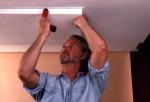Search engine visitors - click here to access entire "$ensible Home" web site
Click here to see a descriptive illustration of several electric radiant ceiling/wall kits and systems.
Dear Jim: You recently wrote about electric radiant floor heating for comfort and silent operation, but I prefer wall or ceiling radiant heating instead. Is it as efficient as floor heating for just one or two rooms? - Don R.

A: Electric wall and ceiling radiant heating systems are ideal for just one room or your entire house. Installation is fairly simple in an existing room without the extensive work often required when adding a floor radiant system.
Radiant heat from the walls or ceilings is very efficient. People often do not realize that heat energy (like from the sun) travels equally well in all directions: up, down and sideways. It is heated air, not heat energy, that naturally moves upward because it is less dense than cooler room air.
In addition to being energy efficient, you cannot beat the comfort from a radiant heating system. It warms your body and objects in the room without overheating and drying out the room air. With radiant ceiling or wall heating panels, furniture does not block the direct heat path to your body.
These systems are particularly popular with people who have allergies. With very little air movement, as compared to a typical ducted forced-air heating system, there is less airborne dust, mold spores, animal dander, etc.
You have quite a few options for installing electric ceiling or wall radiant heating. Attaching a long (3 to 11 feet), narrow radiant cove heater on the wall near the ceiling is effective. The front radiant surface gets warm to heat you like the sun does while it heats the air just a little from natural convection.
Another option is simply attaching electric radiant panels to the wall or ceiling. Radiant panels with three heat settings (500, 625 and 750 watts) are two feet by four feet and thin (one inch). Since the panel surface does not get extremely hot, it can be painted to match any room color.
These same types of panels are sized to fit into a standard dropped-ceiling grid. With their shallow depth, you don't lose much ceiling height. This is also a good time to add some efficient fluorescent light fixtures.
If you are doing a major remodeling job, a low-heat density carbon film can be stapled between the floor joists or wall studs. The soft heat will radiate through the drywall. Drywall panels, with the radiant heating wiring already embedded in them, are also available for installation on ceilings or walls.
For spot heating a small area, use an efficient 170-watt freestanding mini-under-desk radiant heater. There are special ceiling radiant panels for bathrooms designed for simple installation of the vent fan and light. To heat a small room, consider a tall quartz radiant heater with three heat settings.
Instant Download Update Bulletin No. 778 - buyer's guide of 11 electric radiant panel, film, cove, and quartz heater manufacturers listing panels sizes and cove heater lengths, wattage heat outputs at various settings, comfort controls and thermostat types available, design and installation features, illustrations of many systems and an electricity cost-to-use-per-month chart.
Dear Jim: I am building a sunroom kit that has an aluminum frame. What type of caulking material should I use between the frame members and the glass? It will be pretty cold when I apply it. - Henry F.
A: I recently built an aluminum sunroom kit over the patio in my own backyard and I used high-grade silicone caulking. Silicone stays flexible to handle the expansion and it applies easily in chilly weather.
Caulk the joints as you assemble them so the caulking gets inside the joint, not just over it. With the extreme temperature variations in a sunroom, even the best caulking will fail if it is not inside the joints.